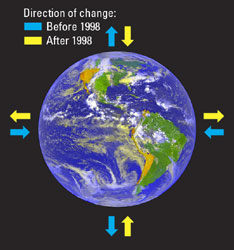What's new in exploration
The baffle of the bulge. For the past 18,000 years, our planet has been slimming. Now, it’s suddenly starting to bulge in the middle. Researchers are baffled. While there are explanations for slight changes in the Earth’s dimensions, none of them account for a shift this big, this fast. The first satellites showed that Earth is rather pear-shaped, and because it is spinning and made largely of somewhat elastic rock, it is a bit wider around the equator. The difference is slight – Earth’s equator is only about 0.3% greater than its height. Using lasers to detect gravitational effects, more accurate measurements of satellite orbits revealed that the Earth was becoming gradually more spherical, at least during the ’80s and ’90s. It was thought that this was a rebound effect due to the melting ice caps after the most recent Ice Age: as their weight was removed from the poles, the poles were rising back to their original position. But the slimming has reversed since 1998, says Christopher Cox at Raytheon, a research and technology company in Lanham, Maryland, and Benjamin Chao at NASA’s Goddard Space Flight Center in Greenbelt, also in Maryland. The sudden change is at least twice as large as the effect of ice-cap melting, says Cox. "It’s a mystery, but probably an explainable one," says Anny Cazenave, an Earth scientist at the National Centre for Space Studies in Toulouse, France. If matter is being redistributed toward the equator, where does it come from? Cox and Chao reckon that the expansion is too fast to be due to flow in the Earth’s mantle or crust. Neither has there has been any measurable change in the weight of the atmosphere. Ice-cap melting as a result of global warming could release more water to equatorial regions, but there has been no rise in sea level detected. The latest conjecture is that a flipping of the Earth’s magnetic field could be part of the cause. These electromagnetic reversals occur about once a decade, when the Earth’s liquid metal core moves. Such a switch occurred in 1999, which could have followed a transfer of molten metal away from the poles toward the equator, Cox and Chao suggest. This is a plausible explanation, says Cazenave. But she argues that "it’s probably not the only factor," as Earth’s core does not weigh enough. She suspects that a change in ocean currents may be piling more water around the equator than before, adding to the effect. More recent data "strongly implicate the oceans," agrees Cox. One thing is almost certain: The phenomenea is probably just a passing phase and not a result of human activity. "We think it’s part of long-term natural variation in climate and the oceans, and things will probably return to normal again," he says. "But we could be wrong."
A series of remarkable discoveries. BP Trinidad and Tobago has discovered 1 Tcf of gas (or 180 MMboe) in its Iron Horse field located off the east coast of Trinidad. This is the company’s second major natural gas discovery for 2002 and its fourth in three years, raising BPTT’s estimated gas reserves to 17 Tcf. Iron Horse was discovered in mid-July some 24 mi off Trinidad and Tobago’s east coast, close to Amherstia, Cassia and Red Mango fields. The discovery well was drilled by the jackup Ensco 76 in 230 ft of water. It was spudded June 12, drilled vertically and completed on August 8 at a 13,471-ft TD. Agip Petroleum Co. drilled a successful Gulf of Mexico deepwater subsalt appraisal at K2 field on Green Canyon Block 562, about 180 mi south of New Orleans. The K2-2 well was spudded in April 2002 in about 3,900 ft of water and reached its target depth of 25,700 ft. Results from this discovery extend the limit of proven oil both laterally and downdip on the K2 structure. Additional appraisal drilling is planned on K2 for 2003. Initial results from the well indicate that commercial development is likely with first production as early as 2004. Previously, in May 1999, a K2-1 well and sidetrack had been drilled on the same block, about 4,000 ft away. The well encountered only one zone with 60 ft of net pay. The K2-2 appraisal found 134 ft in the same interval, plus two new zones that total 339 feet of pay. Anadarko holds a 52.5 percent working interest in the project; other partners include AGIP (operator-18.2%), Conoco (16.8%) and Unocal (12.5%). The K2 discovery is within 6 miles of the Marco Polo field – a discovery located at Green Canyon Block 608, which was announced by Anadarko in 2000. Eni has successfully completed the Baraka South East-1 exploration well offshore Tunisia, about 60 mi southeast of Tunisi. The well, drilled in 300-ft-deep water, reached a total depth of 7,546 ft. Production tests flowed 4,600 bpd of high-quality oil. Development plans are underway; the production phase envisions the use of an FPSO. For several years, PDVSA has had disappointing exploration results – until now. The national oil company hit a big discovery in the Tomoporo area of Lake Maracaibo, which could yield one billion barrels of light crude, according to the Venezuelan Energy Ministry. PDVSA will not release any further details on the discovery until further seismic work has been completed. Petronas Carigali made a discovery in the Turkmenistan sector of the Caspian Sea with the East Livanov-2A well. The well, located in Block 1, tested 19.03 MMcfd of gas and 14,200 bpd of oil and was drilled by the jackup Iran Khazar. This is the third well drilled in the East Livanov area. Petronas operates and holds a 100% interest in Block 1 according to a production-sharing contract with Turkmenoil, the Turkmenistan national oil company.
|
- Quantum computing and subsurface prediction (January 2024)
- Machine learning-assisted induced seismicity characterization of the Ellenburger formation, Midland basin (August 2023)
- Regional Report: Guyana-Suriname (July 2023)
- What's new in exploration (March 2023)
- Regional Report: Brazil (February 2023)
- Seismic and its contribution to the energy transition (January 2023)




